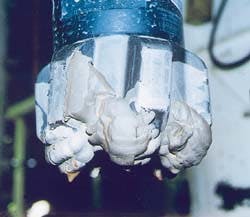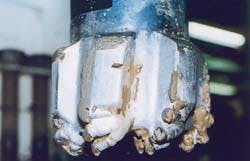Graham Mensa-Wilmot
GeoDiamond HoustonRobert L. Garrett
Garrett Fluid Technology The Woodlands, Tex.Rebecca S. Stokes
Coastal Superior Solutions Inc. Lafayette, La.
In Test 1 without any lubricant, ROP reached 34 ft/hr before the bit balled with a 12,000 lb WOB (Fig. 2).
In Test 3 with 3% lubricant, even with a 21,000 lb WOB, drilling continued at 122 ft/hr ROP. No shale is seen on the bit (Fig. 3).For drilling operations, a new polyalphaolefin (PAO) lubricant improves penetration rates by reducing bit balling tendencies in water-based mud.
The additive also reduces drillstring drag. This enables the effective transmission of weight to the bit and thereby increases drilling efficiency in such applications as directional and horizontal drilling.
Drilling advances
Operators, contractors, and service companies are continuously making technological improvements to meet the challenging needs of today's drilling. With regard to drill bits, bits now stay in the hole longer and drill faster. Besides this expanded applications envelope, drill bits can now more effectively handle formations with vastly different mechanical and mineral properties.
But problems still remain in designing bits that can transition from a soft into a hard formation, or vice versa, while maintaining an effective penetration rate.
Traditionally, features required for an effective soft formation drilling bit reduce their efficiency in hard formations. In such instances, drilling engineers have had to either make a trip to replace the ineffective bit, or leave it in the hole to perform suboptimally.
Both choices will unnecessarily increase drilling cost.
In light of this, the drilling industry stands to gain from any technology that enhances bit performance.
Bit balling
Bit balling is a primary cause of a slow rate of penetration (ROP) in soft formations. Although several types of balling have been identified by different authors, the most common form is observed when a drill bit is unable to rid itself of generated cuttings.
The severity of this condition is dependent on formation mineralogy, bit type and design, and a bit's operating hydraulic regime.
Factors affecting the magnitude of balling can further be separated into two classes: uncontrollable and controllable. Uncontrollable factors, such as formation type and mineralogy, cannot be altered while controllable factors can be changed during drilling.
To inhibit bit balling and thus improve ROP, it is imperative to find solutions for problems caused by the controllable factors.
Laboratory testing
Six full-scale drilling tests were performed in a laboratory, under fully instrumental and computerized conditions for efficient test control and data collection.
The tests evaluated the benefits of the new mud additive, and identified the required concentration levels for effectively inhibiting bit balling.
This type of testing offers the best approach to product evaluation under controlled conditions. It also permits an effective isolation of the variable being investigated, which in this case was the mud lubricant.
Testing conditions
Laboratory testing was done with a slightly weighted freshwater mud containing bentonite. The formulated mud had rheological properties similar to muds common for drilling the intermediate hole sections in the Gulf of Mexico area and in other drilling environments with long shale sections.
Treatments before each test maintained the mud properties.
Catoosa shale was selected for the test program. It was cored from a near-surface location east of Tulsa. This formation is extensively used in laboratories to investigate balling tendencies of different bit designs, mud formulations, and additives.
A confining pressure of 3,000 psi was kept on the rock sample. The pressure was applied by a back-pressure on the flow line with a choke valve. The compressive strength of Catoosa shale is 3,200 psi at a borehole pressure of 1,100 psi.
The tests used a 61/2-in. polycrystalline diamond compact (PDC) bit, IADC M333, with six blades, 13-mm PDC cutters, and three nozzles. The bit was selected because of its proven field performance in similar applications.
Because of its blade count, cutter size, and design specifications, this bit has traditionally drilled very well in environments where durable bits were required to handle hard and soft formations in a single run.
Testing methodology
The tests required a constant rotational speed on the bit and a constant total flow area. Each of the six tests had a different flow rate and/or additive volume.
Weight on bit (WOB) was linearly increased for each of the tests, from 3,000 to 21,000 lb. The bit was fitted with three 12/32-in. nozzles, yielding a 0.33 sq in. total flow area, while the bit rotation was held constant at 120 rpm.
The above conditions were selected because laboratory tests have shown that maintaining rotation speed and increasing WOB in sticky formation drilling, such as in the Catoosa shale, normally induced bit balling.
Tests results
Table 1 [15971 bytes] lists the parameters that were held constant, and summarizes the conditions in each test.
Test 1 was at 250 gpm with no lubricant. Fig. 1a [108835 bytes] shows the ROP and torque responses of the bit plotted against the different WOBs.
The bit effectively cleaned itself at WOBs up to 12,000 lb. Above this value, it experienced a decay in ROP and a change in it's torque response. When the WOB was increased from 12,000 to 15,000 lb, it's torque signal remained flat, signifying that the bit had balled up.
A maximum 34 ft/hr ROP was achieved before balling at a 12,000 lb WOB (Fig. 2).
Test 2 also had no lubricant but the pump rate was increased to 300 gpm. The ROP and torque responses of the bit, plotted against the different WOBs are shown in Fig. 1b [108835 bytes].
The bit was able to adequately clean itself of any generated cuttings during Test 2. The strong linearity in the ROP and torque-vs.-WOB show that there was no balling. The bit experienced no decay or saturation in its ROP and torque responses even as WOB was increased to 21,000 lb. A maximum 124 ft/hr ROP was achieved at a 21,000 lb WOB.
Fig. 1c [108835 bytes] shows the bit ROP and torque responses during Test 3, at 250 gpm and 3% lubricant. Similar to the previous test, the bit rid itself of generated cuttings during this test (Fig. 3). The ROP and torque responses to WOB show strong linearity with no decay or saturation. The bit is still responding to increasing WOB even at 21,000 lb. A maximum ROP of 122 ft/hr was achieved at a 21,000 lb WOB.
In Test 4 (Fig. 1d [108835 bytes], 300 gpm and 3% lubricant) the bit's response was similar to that seen on Tests 2 and 3. The ROP and torque responses show strong linearity to WOB. At a 21,000 lb WOB, the ROP was 122 ft/hr.
Test 5 (Fig. 1e [108835 bytes], 250 gpm, 6% lubricant) shows the ROP and torque responses are linear to WOB. The bit responded well to increasing WOB and experienced no decay or saturation in ROP or torque. At a 21,000 lb WOB, the ROP was 108 ft/hr.
The final test, Test 6 (Fig. 1f [108835 bytes], 200 gpm, 6% lubricant), shows the bit's ROP and torque respond significantly to increasing WOB, up to 12,000 lb. Between 12,000 and 15,000 lb WOB, the ROP becomes flat and it can be assumed, based on comparing the flow rate in this test to the rate in Test 1, that the bit has balled.
However, the bit was able to rid itself of the generated cuttings and re-establish the linearity between its ROP and torque responses between 15,000 and 21,000 lb WOB. At a 21,000 lb WOB, the ROP was 75 ft/hr.
Test analysis
At a flow rate of 250 gpm and with no lubricant in the mud system (Test 1a), the bit balled up at a 12,000 lb WOB upon reaching a 34 ft/hr ROP. However, addition of 3% mud lubricant by volume prevented balling, and enabled the bit to exhibit a favorable ROP and torque response (Test 3) with increasing WOB. Under these conditions, the bit achieved a 122 ft/hr ROP with a 21,000 lb WOB.
At an increased flow rate of 300 gpm and with no lubricant (Test 2) in the mud system, the bit's behavior was similar to that of Test 3 (250 gpm and 3% lubricant) and Test 4 (300 gpm and 3% lubricant). This showed that the addition of a mud lubricant can provide the same benefits as higher flow rates.
In addition, once the optimum flow rate and lubricant volume is achieved, increasing flow rate to enhance cleaning was unnecessary.
Increasing lubricant to 6% at a 250 gpm flow rate (Test 5) did not enhance the bit's performance, when compared to the bit's behavior at 250 gpm and a 3% lubricant content (Test 2). This showed that the lubricant's effectiveness was not proportional to it's volumetric concentration, once the needed levels are established for a drilling program or environment.
At a reduced 200 gpm flow rate, and a 6% lubricant concentration (Test 6), the bit's behavior improved when compared to its performance at 250 gpm and no lubricant (Test 1). This indicates that even under conditions where a bit was definitely expected to ball, lubricant addition prevented bit balling.
Acknowledgment
The authors would like to thank George Hanst of Coastal Superior Solutions and Diane Jordan of GeoDiamond for contributing to this article. Also help was provided by Dave Durrough of Amoco Corp.'s research center in Tulsa.
The Authors
Graham Mensa-Wilmot is the manager of technology development at Geodiamond, a division of Smith International Inc., Houston. He is involved in the engineering and development of PDC bits.Mensa-Wilmot has an MS in drilling and production engineering from the Oil & Gas Institute of Ploiesti in Romania.
Robert L. Garrett operates Garrett Fluid Technology, The Woodlands, Tex. He is involved in water and oil mud chemistry, properties, and testing. Garrett is a graduate of Texas Tech University and served as chairman of several API committees, including a 15 year tenure with the API task force on oil mud testing.
Rebecca S. Stokes is president of Coastal Superior Solutions Inc., Lafayette, La. The company manufactures and markets drilling fluid additives. She has more than 20 years of experience in the drilling fluid and chemical industry. Prior to forming Coastal Superior Solutions, Stokes was president of Coastal Mud Inc. She attended LSU and is a member of the National Oil Industries Associations synthetic drilling fluid industry group.
Copyright 1997 Oil & Gas Journal. All Rights Reserved.







